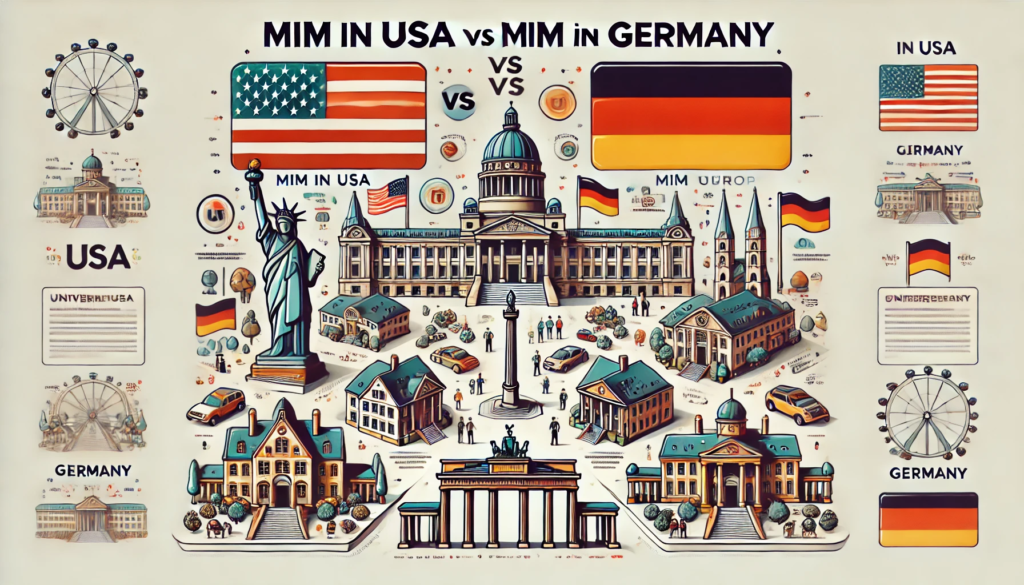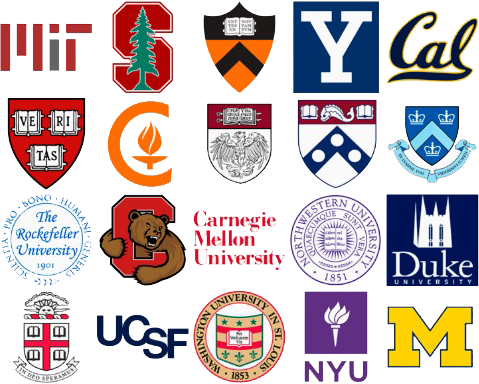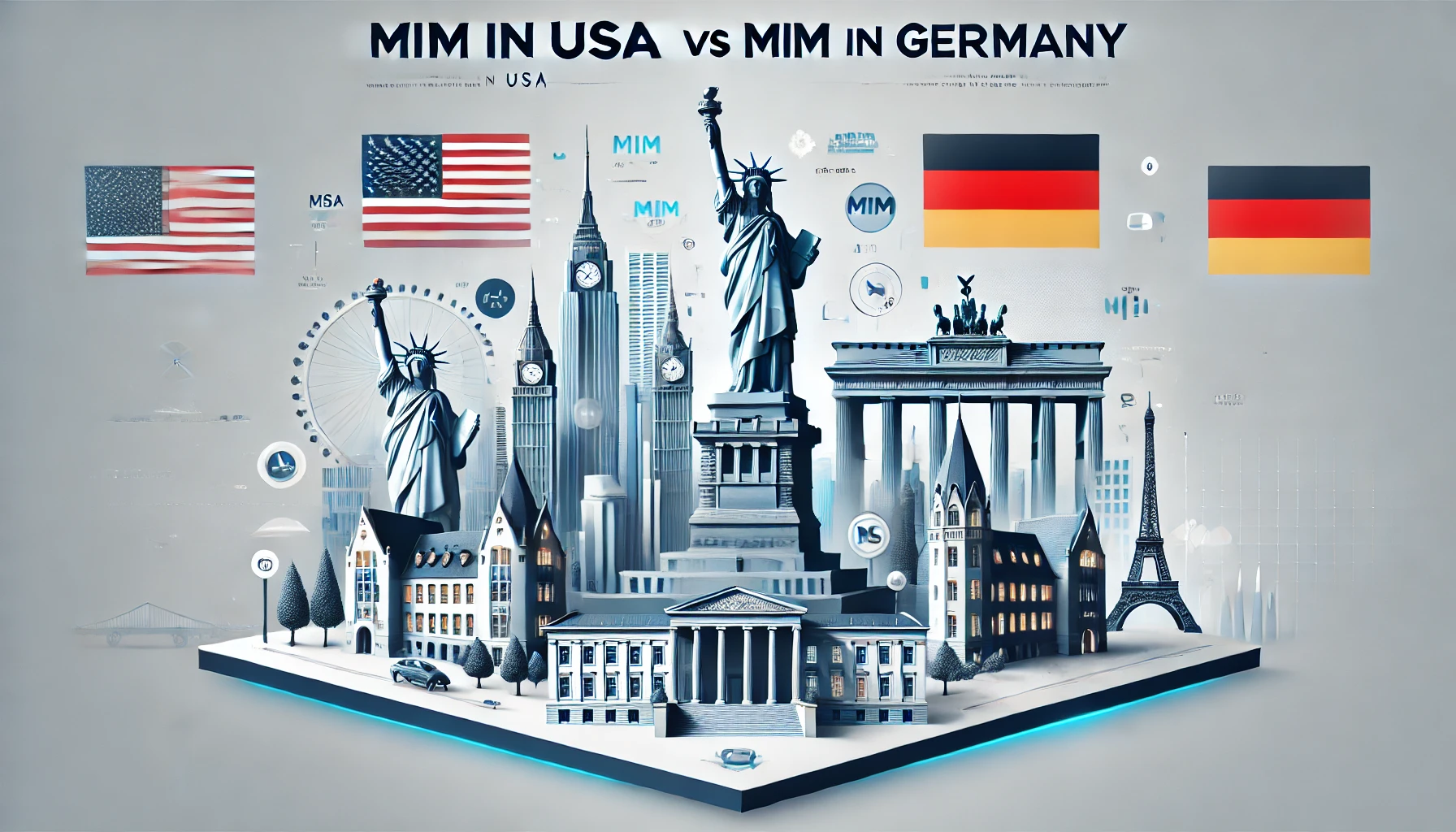Choosing between pursuing a MiM in USA vs MiM in Germany is a critical decision for students aiming to accelerate their careers in business and management. Both countries offer globally recognized MiM programs but differ significantly in their admission processes, cost structures, job opportunities, and overall student experience.
The USA is known for its dynamic business ecosystem, extensive alumni networks, and STEM-designated programs, which offer additional work opportunities. On the other hand, Germany attracts students with its affordable tuition fees, robust industrial base, and focus on research-driven education.
This blog explores the five key differences between MiM programs in these two countries, addressing factors such as admission requirements, salaries, tuition costs, job opportunities, and global reputation. By the end, you’ll have actionable insights to make an informed decision about your academic and professional future.
1. Admission Requirements

MiM in the USA: Holistic Approach to Applications
Admission to MiM programs in the USA typically emphasizes a holistic review of an applicant’s profile. While academic performance is essential, universities also prioritize leadership qualities, extracurricular achievements, and personal essays. Most US institutions require applicants to have a four-year undergraduate degree from an accredited institution. Additionally, standardized test scores such as the GMAT or GRE are often mandatory, although many schools now offer waivers for candidates with exceptional academic or professional records.
English proficiency tests like the TOEFL or IELTS are a standard requirement for non-native English speakers. Candidates are also expected to submit Letters of Recommendation (LORs) and a Statement of Purpose (SOP), both of which carry significant weight in the evaluation process. Moreover, US schools often assess a candidate’s leadership potential and cultural fit through personal interviews, which play a key role in final admissions decisions.
Key Fact: According to a GMAC survey, over 80% of MiM programs in the USA require GMAT scores, while 95% require TOEFL/IELTS proficiency proof.
MiM in Germany: Academic Rigor with Structured Requirements
In contrast, MiM programs in Germany often have a more academically structured admission process with a heavy focus on grades and academic performance. Applicants typically need a 3- or 4-year undergraduate degree, and the degree must align with the European Credit Transfer and Accumulation System (ECTS) requirements. Most programs require at least 180–240 ECTS credits for admission eligibility.
While standardized test scores like the GMAT or GRE are required in some institutions, others may rely on academic transcripts and GPA cut-offs as primary evaluation criteria. Certain programs, particularly in public universities, may require basic German language proficiency even if the program is taught in English. Additionally, German universities place less emphasis on personal essays and interviews. Instead, they prioritize academic merit, research potential, and professional clarity reflected in the application documents.
Key Fact: According to Statista, over 60% of MiM applicants in Germany are admitted based on academic grades and ECTS credits, with standardized test scores often being secondary requirements.
Additional Considerations in Admission Processes
One key difference is the focus on extracurriculars and essays in the USA versus the emphasis on academic transcripts and grades in Germany. While US programs often encourage students with diverse professional and academic backgrounds, German programs maintain a relatively rigid academic structure. Furthermore, interview requirements are more common in the USA, where schools aim to assess interpersonal skills, communication abilities, and leadership qualities. In Germany, interviews are less frequent and are usually reserved for highly competitive or specialized programs.
Ultimately, if you prefer a system that values a well-rounded application, the USA might be the better fit. However, if your academic performance and structured requirements align with the German education model, Germany could offer a smoother pathway to success.
2. Average Salaries After Graduation

Salaries in the USA: High Earning Potential with Regional Variations
Graduates of MiM programs in the USA often enter industries like consulting, finance, and technology, where salaries are typically competitive. On average, entry-level MiM graduates in the USA earn between $60,000 and $80,000 annually, depending on factors such as location, industry, and employer reputation. For instance, graduates working in cities like New York, San Francisco, or Chicago—known for their thriving business ecosystems—often command higher salaries due to the high cost of living and demand for skilled professionals.
Furthermore, many STEM-designated MiM programs allow international students to extend their Optional Practical Training (OPT) period to 36 months, providing an extended window to gain valuable industry experience in the USA. Data from the U.S. Bureau of Labor Statistics (BLS) reveals that the median salary for management professionals in the USA stands at $97,970 annually, highlighting the long-term earning potential for MiM graduates as they advance in their careers.
Key Insight: Top hiring industries for MiM graduates in the USA include consulting (30%), technology (25%), and finance (20%), with firms like McKinsey, Deloitte, and Goldman Sachs actively recruiting.
Salaries in Germany: Stability with Lower Entry-Level Salaries
In Germany, entry-level salaries for MiM graduates generally range between €40,000 and €50,000 annually. While this may seem lower compared to US salaries, the lower cost of living in many German cities balances the scales, offering a relatively high quality of life. Cities like Munich, Frankfurt, and Berlin are hotspots for MiM graduates, with industries such as automotive, finance, and technology providing robust employment opportunities. Additionally, Germany’s emphasis on engineering and manufacturing sectors creates specialized opportunities for MiM graduates with an interest in operational management.
Language proficiency can significantly influence salaries. Graduates proficient in German often secure higher-paying roles, as many mid-level and senior roles require fluency. According to data from Statistisches Bundesamt, Germany’s official statistical office, graduates working in financial hubs like Frankfurt tend to earn 15-20% higher salaries compared to those in other cities.
Key Insight: Major recruiters in Germany include BMW, Bosch, Allianz, and Deutsche Bank, with consulting firms like EY and PwC also playing a significant role in graduate employment.
Comparing Salary Structures: MiM in USA vs MiM in Germany
While MiM salaries in the USA are generally higher in absolute terms, the cost of living, taxation, and visa limitations should be considered when evaluating overall financial benefits.
- USA: Higher starting salaries, greater earning potential in tech and finance sectors, and extended STEM OPT opportunities.
- Germany: More affordable living costs, stable job market, and long-term residency opportunities through the 18-month post-study work visa.
Salary Growth Potential
In the USA, MiM graduates often experience rapid salary growth due to performance bonuses, stock options, and structured promotion pathways. In Germany, salary progression is more incremental but stable, particularly in industries like finance and manufacturing.
Ultimately, if your goal is immediate financial returns and expansive job opportunities, the USA might be the ideal choice. Conversely, if you’re drawn to long-term stability, affordable living, and a focus on industrial sectors, Germany offers a compelling proposition.
3. Program Fees & STEM-Equivalent Designations

MiM in the USA: Significant Investment with STEM Advantages
Pursuing an MiM in the USA requires a substantial financial commitment. Tuition fees typically range between $35,000 and $60,000 per year, depending on the university’s reputation, location, and facilities. Top-ranked institutions like Duke University (Fuqua School of Business) or University of Michigan (Ross School of Business) often charge tuition at the higher end of this range. Additionally, students need to budget for living expenses, healthcare, and miscellaneous costs, which can amount to $15,000–$20,000 annually, especially in cities like New York, Boston, or San Francisco.
One significant advantage of studying in the USA is the STEM (Science, Technology, Engineering, and Mathematics) designation offered by select MiM programs. A STEM-certified program allows international students to extend their Optional Practical Training (OPT) period to 36 months, compared to the standard 12-month OPT available for non-STEM programs. This extended period provides students with additional time to gain valuable work experience and increases their chances of securing H-1B visa sponsorships.
Scholarships and Funding Opportunities: Many universities offer merit-based scholarships, assistantships, and external funding programs to reduce the financial burden. International students may also apply for Fulbright Scholarships or private grants.
Key Insight: According to the Graduate Management Admission Council (GMAC), 60% of MiM students in the USA rely on scholarships or financial aid to manage tuition costs.
MiM in Germany: Cost-Effective with Limited STEM Opportunities
Germany is widely regarded as one of the most affordable study destinations in Europe, and this holds true for MiM programs as well. Tuition fees vary significantly between public and private universities. At public universities, MiM programs often have little to no tuition fees, with students required to pay only a semester fee (around €200–€400 per semester). In contrast, private universities charge tuition fees ranging from €15,000 to €30,000 for the entire program.
Living costs in Germany are also relatively affordable, averaging around €850–€1,200 per month, depending on the city. Cities like Berlin and Leipzig are more budget-friendly compared to financial hubs like Frankfurt and Munich. Unlike the USA, STEM designations are less common in German MiM programs. While some specialized tracks may qualify, most MiM degrees fall under non-STEM categories, limiting the post-study work benefits available to international students.
Scholarships and Funding Opportunities: Germany offers several attractive funding options, including the DAAD (Deutscher Akademischer Austauschdienst) scholarships, Deutschlandstipendium, and university-specific grants.
Key Insight: According to the DAAD, nearly 60% of international students in Germany study tuition-free at public universities, significantly reducing their financial burden.
Comparing Program Fees: MiM in USA vs MiM in Germany
| Aspect | USA | Germany |
|---|---|---|
| Tuition Fees | $35,000–$60,000 annually | €200–€400 per semester (public) / €15,000–€30,000 (private) |
| Living Costs | $15,000–$20,000 annually | €850–€1,200 monthly |
| Scholarships | Merit-based, Fulbright, assistantships | DAAD, Deutschlandstipendium, university grants |
| STEM Designation | Available in select programs | Rare in MiM programs |
Return on Investment (ROI)
The ROI for MiM programs in the USA can be significant if students leverage the 36-month OPT extension and secure employment in high-paying sectors like finance, consulting, or tech. In contrast, the ROI in Germany is heavily influenced by the low tuition fees and cost of living. Graduates who secure employment in sectors like automotive, finance, and technology often find their initial investment pays off within a few years.
If you’re looking for a high-earning career with a focus on tech and finance, the USA offers better opportunities. However, if affordability and lower financial risk are your priorities, Germany is a more prudent choice.
4. Job Opportunities & Post-Study Work (PSW)

Job Market in the USA: Diverse Industries and STEM Advantage
The USA offers a robust and dynamic job market for MiM graduates, with opportunities across sectors such as finance, consulting, technology, healthcare, and retail. Major business hubs like New York, San Francisco, Boston, and Chicago attract top employers looking for skilled management professionals. One key advantage for international students pursuing an MiM in the USA is the availability of STEM-designated programs. Graduates from these programs can extend their Optional Practical Training (OPT) period to 36 months, providing additional time to secure a long-term work visa such as the H-1B visa.
Top firms, including McKinsey, Deloitte, Amazon, and Google, actively recruit MiM graduates, offering roles such as Business Analyst, Project Manager, and Strategy Consultant. However, securing an H-1B visa remains a challenge due to quota limitations and the lottery system. Candidates often rely on securing employment with companies experienced in visa sponsorships to navigate these hurdles effectively.
Key Fact: According to data from the GMAC Employment Report, over 85% of MiM graduates from US business schools secure employment within three months of graduation, with average salaries ranging between $60,000–$80,000 annually.
Job Market in Germany: Stability with an Industrial Focus
Germany’s economy is characterized by its strong industrial base, with key sectors including automotive, engineering, finance, and technology. Cities such as Frankfurt (finance), Munich (automotive and tech), and Berlin (startups and innovation) are prime employment hubs for MiM graduates. Unlike the USA, Germany offers an 18-month post-study work visa (Aufenthaltserlaubnis), allowing international students ample time to search for jobs after graduation. This visa can also serve as a pathway to a permanent residence permit if specific conditions are met.
Proficiency in the German language is often a crucial factor in securing high-paying jobs. While many international companies operate in English, fluency in German significantly increases employment prospects, particularly in mid-level management roles. Prominent employers include Siemens, BMW, Allianz, Bosch, and Deutsche Bank, offering roles such as Operations Manager, Financial Analyst, and Strategy Consultant.
Key Fact: According to Statistisches Bundesamt, over 70% of international graduates in Germany secure employment within six months of completing their degree, with average starting salaries ranging from €40,000–€50,000 annually.
Comparing Job Opportunities: MiM in USA vs MiM in Germany
| Aspect | USA | Germany |
|---|---|---|
| Top Industries | Finance, Tech, Consulting | Automotive, Finance, Engineering |
| Post-Study Visa | 12–36 months (OPT extension) | 18-month job search visa |
| Visa Sponsorship | H-1B lottery-based system | Clear pathway to residence |
| Language Requirement | English proficiency is sufficient | German proficiency preferred |
| Employment Rate (6 months) | 85%+ | 70%+ |
Work Visa and Residency Pathways
In the USA, transitioning from an OPT visa to an H-1B work visa is often dependent on the annual H-1B lottery system, making it less predictable. On the other hand, Germany’s 18-month job search visa offers a structured and stable pathway to permanent residency.
- USA: OPT extension (up to 36 months for STEM graduates) → H-1B visa → Green Card.
- Germany: 18-month job search visa → Permanent Residence Permit (if eligibility criteria are met).
Career Growth Trajectories
In the USA, career growth in management roles is often performance-driven, with opportunities for rapid promotions, performance bonuses, and stock options. In Germany, career progression tends to be structured and gradual, focusing on long-term stability and expertise.
Key Takeaways for Job Opportunities:
- The USA offers higher earning potential, dynamic job markets, and extended OPT periods, but visa pathways can be uncertain.
- Germany provides stable visa options, affordable living costs, and long-term residency pathways, but language barriers may pose challenges.
If you prioritize high salaries and dynamic industries, the USA is a clear winner. However, if visa stability, industrial hubs, and cost-effectiveness are your priorities, Germany might align better with your goals.
Frustrated with Generic College Lists from AI Tools?
Get a tailored college shortlist crafted by study abroad experts who understand YOUR goals, profile, and aspirations.

5. Global Value & Recognition
USA’s Global Reputation: Emerging Recognition for MiM Degrees
The USA has long been regarded as a global leader in higher education, home to prestigious institutions like Harvard Business School, Stanford Graduate School of Business, and MIT Sloan. While MBA programs dominate the US business education landscape, MiM programs are relatively newer but are rapidly gaining recognition. Leading business schools in the USA are tailoring MiM programs to meet the demands of a diverse, global workforce. These programs often emphasize case-based learning, entrepreneurial thinking, and leadership development to prepare graduates for managerial roles across industries.
One standout feature of US MiM programs is their focus on building strong alumni networks and providing access to global corporate partnerships. This network is invaluable for internships, job placements, and long-term professional growth. Furthermore, the STEM designation in select MiM programs enhances their value by allowing extended work opportunities under the OPT visa program. According to the QS Business Masters Rankings, US-based MiM programs are consistently climbing global rankings, with institutions like Duke Fuqua and Michigan Ross leading the way.
Key Fact: Graduates from top US MiM programs often find opportunities in global consulting firms, Fortune 500 companies, and emerging tech startups, making the degree highly marketable worldwide.
Germany’s Global Reputation: Established Legacy in Business Education
Germany has a long-standing reputation for academic excellence and rigorous educational standards, especially in the field of management studies. MiM programs in Germany, particularly at institutions such as ESMT Berlin, WHU Otto Beisheim School of Management, and Mannheim Business School, are recognized globally for their research-driven curricula and strong ties to industry.
European business schools, including those in Germany, have historically been at the forefront of MiM education. These programs emphasize analytical skills, strategic decision-making, and cross-cultural leadership, preparing graduates for managerial roles across Europe and beyond. Additionally, many German MiM programs have strong partnerships with leading multinational corporations, offering internship placements, on-site projects, and corporate mentorship opportunities.
The European Foundation for Management Development (EFMD) and Association to Advance Collegiate Schools of Business (AACSB) accredit many German MiM programs, ensuring they meet global education standards.
Key Fact: According to the Financial Times Global MiM Rankings, German schools like ESMT Berlin and Mannheim Business School consistently rank among the Top 20 globally, underlining their strong reputation in Europe and beyond.
Where is MiM More Popular: USA vs. Germany?
Traditionally, MiM programs have been more popular in Europe, with Germany being a key destination for international students seeking affordable yet high-quality management education. However, the USA is rapidly catching up, with top business schools launching competitive MiM programs tailored to meet the needs of a globalized workforce.
| Aspect | USA | Germany |
|---|---|---|
| Global Rankings | Emerging but improving | Historically strong in MiM rankings |
| Alumni Network | Strong and global | Strong in Europe, growing globally |
| Accreditation Bodies | AACSB, AMBA | AACSB, AMBA, EFMD |
| Popularity of MiM | Increasing | Well-established |
| Employability Focus | Case-based learning, internships | Research-driven, industrial partnerships |
Industry Preference: USA vs. Germany
In the USA, MiM graduates are particularly valued in consulting, finance, and technology sectors, where managerial skills, problem-solving abilities, and leadership qualities are highly sought after. The focus is on dynamic, high-growth industries where career progression is often rapid. In Germany, the emphasis is more on industrial, engineering, and financial sectors, with long-term employment stability and structured career growth being central themes.
Global Perception and Recognition
- USA: Recognized globally, particularly in North America and emerging Asian markets. The MiM degree is gaining traction alongside traditional MBA programs.
- Germany: Highly respected across Europe, especially in countries like France, Switzerland, and the Netherlands. German MiM degrees are synonymous with academic rigor and industrial relevance.
Key Takeaways for Global Recognition:
- If your goal is to access global networks, corporate partnerships, and dynamic job markets, the USA offers an ideal platform.
- If you’re drawn to affordable education, industrial-focused career pathways, and long-term stability in Europe, Germany provides unmatched value.
FAQs
Is work experience required for MiM programs in the USA and Germany?
Work experience is generally not mandatory for MiM programs in either the USA or Germany, as these degrees are designed primarily for recent graduates with little to no professional experience. However, having relevant internships, part-time jobs, or leadership roles in student organizations can significantly strengthen your application. In the USA, schools often look for strong extracurricular engagement and impactful personal essays. Meanwhile, German universities focus more on academic performance, GPA, and ECTS credits.
Which is more cost-effective: studying MiM in the USA or Germany?
In terms of affordability, Germany clearly holds the advantage. Public universities in Germany either charge minimal tuition fees or none at all, while private institutions are still considerably cheaper than their US counterparts. Additionally, the cost of living in Germany is more manageable, especially in cities outside financial hubs like Munich or Frankfurt. In contrast, US MiM programs require significant financial investment, with tuition fees ranging from $35,000–$60,000 annually and higher living costs. However, US MiM graduates often earn higher initial salaries, which can balance the financial scales over time.
Is German language proficiency essential for securing a job in Germany after an MiM?
While many German MiM programs are offered in English, German language proficiency can significantly enhance your employment prospects post-graduation. Many entry-level positions in global corporations operate in English, especially in cities like Berlin or Frankfurt. However, fluency in German opens doors to mid-level and senior management positions, improves workplace integration, and broadens your job opportunities across industries. If you’re planning to stay in Germany long-term, investing in language skills is highly recommended.
Can I transition from an MiM to an MBA later?
Yes, an MiM degree can serve as a solid foundation for pursuing an MBA later in your career. Many professionals complete an MiM program, gain a few years of work experience, and then pursue an MBA for senior leadership roles. The MiM equips students with core business fundamentals, analytical skills, and management perspectives, making the transition to an MBA smoother.
Which country offers better ROI: USA or Germany?
The return on investment (ROI) for an MiM program depends on factors such as tuition costs, living expenses, post-graduation salaries, and visa policies. In the USA, higher tuition fees and living costs are offset by higher salaries, a dynamic job market, and extended OPT periods for STEM graduates. In Germany, the lower cost of education and affordable living expenses contribute to a quicker ROI, even though starting salaries are relatively lower. If you’re aiming for long-term financial growth and rapid career advancement, the USA might be more suitable. If you value financial stability and minimal debt, Germany is the smarter choice.
Conclusion
Choosing between an MiM in the USA and an MiM in Germany boils down to your personal and professional priorities. Both countries offer unique strengths: the USA excels in dynamic job markets, higher starting salaries, and STEM-designated programs, while Germany offers cost-effective education, stable job opportunities, and a clear path to permanent residency.
If you’re someone who values networking, rapid career progression, and access to global corporate giants, an MiM in the USA might align better with your goals. On the other hand, if you prioritize affordability, industrial-focused career opportunities, and long-term residency options, Germany could be your ideal choice. Ultimately, the best decision aligns with your financial readiness, career aspirations, and long-term vision. Take time to evaluate your goals, consult with study-abroad experts, and make an informed choice that sets the stage for a fulfilling international career.




